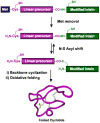Cyclotides, a promising molecular scaffold for peptide-based therapeutics
- PMID: 20564025
- PMCID: PMC3000894
- DOI: 10.1002/bip.21433
Cyclotides, a promising molecular scaffold for peptide-based therapeutics
Abstract
Cyclotides are a new emerging family of large plant-derived backbone-cyclized polypeptides (approximately 30 amino acids long) that share a disulfide-stabilized core (three disulfide bonds) characterized by an unusual knotted structure. Their unique circular backbone topology and knotted arrangement of three disulfide bonds make them exceptionally stable to thermal, chemical, and enzymatic degradation compared to other peptides of similar size. Currently, more than 100 sequences of different cyclotides have been characterized, and the number is expected to increase dramatically in the coming years. Considering their stability and biological activities like anti-HIV, uterotonic, and insecticidal, and also their abilities to cross the cell membrane, cyclotides can be exploited to develop new stable peptide-based drugs. We have recently demonstrated the intriguing possibility of producing libraries of cyclotides inside living bacterial cells. This opens the possibility to generate large genetically encoded libraries of cyclotides that can then be screened inside the cell for selecting particular biological activities in a high-throughput fashion. The present minireview reports the efforts carried out toward the selection of cyclotide-based compounds with specific biological activities for drug design.
Figures



Similar articles
-
Biological activities of natural and engineered cyclotides, a novel molecular scaffold for peptide-based therapeutics.Curr Mol Pharmacol. 2010 Nov;3(3):153-63. doi: 10.2174/1874467211003030153. Curr Mol Pharmacol. 2010. PMID: 20858197 Free PMC article. Review.
-
Chemical synthesis and biosynthesis of the cyclotide family of circular proteins.IUBMB Life. 2006 Sep;58(9):515-24. doi: 10.1080/15216540600889532. IUBMB Life. 2006. PMID: 17002979 Review.
-
Discovery and applications of the plant cyclotides.Toxicon. 2010 Dec 15;56(7):1092-102. doi: 10.1016/j.toxicon.2010.02.021. Epub 2010 Feb 26. Toxicon. 2010. PMID: 20219513 Review.
-
Cyclotides, a versatile ultrastable micro-protein scaffold for biotechnological applications.Bioorg Med Chem Lett. 2017 Dec 1;27(23):5089-5099. doi: 10.1016/j.bmcl.2017.10.051. Epub 2017 Oct 21. Bioorg Med Chem Lett. 2017. PMID: 29110985 Free PMC article. Review.
-
The cyclotide family of circular miniproteins: nature's combinatorial peptide template.Biopolymers. 2006;84(3):250-66. doi: 10.1002/bip.20451. Biopolymers. 2006. PMID: 16440288 Review.
Cited by
-
Asteropsins B-D, sponge-derived knottins with potential utility as a novel scaffold for oral peptide drugs.Biochim Biophys Acta. 2014 Mar;1840(3):977-84. doi: 10.1016/j.bbagen.2013.11.001. Epub 2013 Nov 10. Biochim Biophys Acta. 2014. PMID: 24225326 Free PMC article.
-
Plant-derived mitochondria-targeting cysteine-rich peptide modulates cellular bioenergetics.J Biol Chem. 2019 Mar 15;294(11):4000-4011. doi: 10.1074/jbc.RA118.006693. Epub 2019 Jan 23. J Biol Chem. 2019. PMID: 30674551 Free PMC article.
-
Legume cyclotides shed light on the genetic origin of knotted circular proteins.Proc Natl Acad Sci U S A. 2011 Jun 21;108(25):10025-6. doi: 10.1073/pnas.1107849108. Epub 2011 Jun 8. Proc Natl Acad Sci U S A. 2011. PMID: 21653883 Free PMC article. No abstract available.
-
Prediction of Leymus arenarius (L.) antimicrobial peptides based on de novo transcriptome assembly.Plant Mol Biol. 2015 Oct;89(3):203-14. doi: 10.1007/s11103-015-0346-6. Epub 2015 Sep 14. Plant Mol Biol. 2015. PMID: 26369913
-
Advances in cyclotide research: bioactivity to cyclotide-based therapeutics.Mol Divers. 2025 Jan 25. doi: 10.1007/s11030-025-11113-w. Online ahead of print. Mol Divers. 2025. PMID: 39862350 Review.
References
-
- Saladin PM, Zhang BD, Reichert JM. IDrugs. 2009;12:779–784. - PubMed
-
- Lewis RJ. Adv Exp Med Biol. 2009;655:44–48. - PubMed
-
- Craik DJ, Simonsen S, Daly NL. Curr Opin Drug Discov Devel. 2002;5:251–260. - PubMed
-
- Craik DJ, Cemazar M, Daly NL. Curr Opin Drug Discov Devel. 2006;9:251–260. - PubMed
-
- Craik DJ, Clark RJ, Daly NL. Expert Opin Investig Drugs. 2007;16:595–604. - PubMed
Publication types
MeSH terms
Substances
Grants and funding
LinkOut - more resources
Full Text Sources
Other Literature Sources

